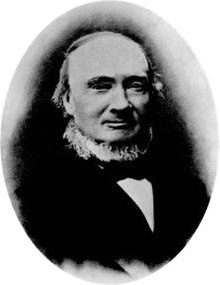Ivar Aasen
| Ivar Aasen | |
|---|---|

Ivar Aasen (1881)
|
|
| Born | Iver Andreas Aasen 5 August 1813 Ørsta, Norway |
| Died | 23 September 1896 (aged 83) Christiania (Oslo), Norway |
| Occupation | Philologist, lexicographer, playwright, poet |
| Language | Norse dialects |
| Nationality | Norwegian |
Ivar Andreas Aasen (Norwegian pronunciation: [ˈiːvɑr ˈɔːsən]; 5 August 1813 – 23 September 1896) was a Norwegian philologist, lexicographer, playwright, and poet. He is best known for having assembled from dialects one of the two official written versions of the Norwegian language, Nynorsk.
Aasen was born at Åsen in Ørsta (then Ørsten), in the district of Sunnmøre, on the west coast of Norway. His father, a peasant with a small farm, Ivar Jonsson, died in 1826. The younger Ivar was brought up to farmwork, but he assiduously cultivated all his leisure in reading. An early interest of his was botany. When he was eighteen, he opened an elementary school in his native parish. In 1833 he entered the household of H. C. Thoresen, the husband of the eminent writer Magdalene Thoresen, in Herøy (then Herø), and there he picked up the elements of Latin. Gradually, and by dint of infinite patience and concentration, the young peasant mastered many languages, and began the scientific study of their structure. Ivar single-handedly created a new language for Norway to become the "literary" language.
About 1841 he had freed himself from all the burden of manual labour, and could occupy his thoughts with the dialect of his native district, Sunnmøre; his first publication was a small collection of folk songs in the Sunnmøre dialect (1843). His remarkable abilities now attracted general attention, and he was helped to continue his studies undisturbed. His Grammar of the Norwegian Dialects (Danish: Det Norske Folkesprogs Grammatik, 1848) was the result of much labour, and of journeys taken to every part of the country. Aasen's famous Dictionary of the Norwegian Dialects (Danish: Ordbog over det Norske Folkesprog) appeared in its original form in 1850, and from this publication dates all the wide cultivation of the popular language in Norwegian, since Aasen really did no less than construct, out of the different materials at his disposal, a popular language or definite folke-maal (people's language) for Norway. By 1853, he had created the norm for utilizing his new language, which he called Landsmaal, meaning country language. With certain modifications, the most important of which were introduced later by Aasen himself, but also through a latter policy aiming to merge this Norwegian language with Dano-Norwegian, this language has become Nynorsk ("New Norwegian"), the second of Norway's two official languages (the other being Bokmål, the Dano-Norwegian descendant of the Danish language used in Norway in Aasen's time). An unofficial variety of Norwegian more close to Aasen's language is still found in Høgnorsk ("High Norwegian"). Today, some consider Nynorsk on equal footing with bokmål, as bokmål tends to be used more in radio and television and most newspapers, whereas New Norse (Nynorsk) is used equally in government work as well as approximately 17% of schools. Although it is not as common as its brother language, it needs to be looked upon as a viable language, as a large minority of Norwegians use it as their primary language including many scholars and authors. New Norse is both a written and spoken language.
...
Wikipedia
